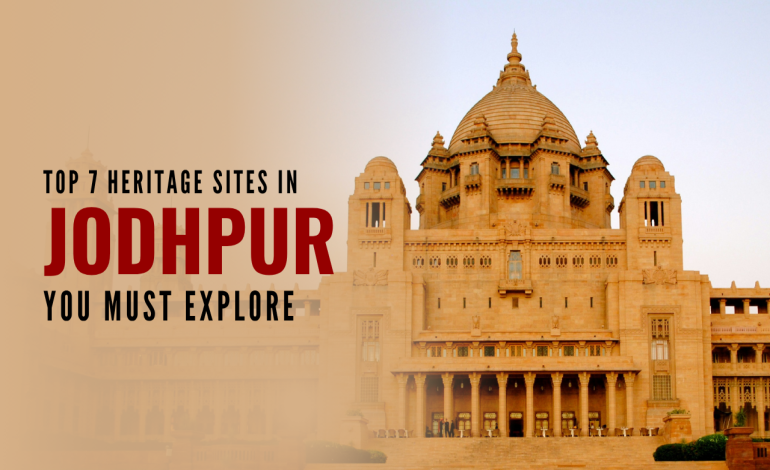
Top 7 Heritage Sites in Jodhpur You Must Explore
Jodhpur, the iconic “Blue City” of Rajasthan, is a vibrant blend of regal history, striking architecture, and colorful traditions. Once the seat of Marwar’s princely state, the city is home to architectural wonders and cultural treasures that have stood the test of time. Whether you\'re a history buff, a photography enthusiast, or a curious traveler, Jodhpur offers an enriching experience through its magnificent heritage sites.
Here’s a guide to the top 7 heritage sites in Jodhpur that you absolutely must explore.
1. Mehrangarh Fort: The Crown Jewel of Jodhpur
Towering 400 feet above the city, Mehrangarh Fort dominates the Jodhpur skyline. Built in 1459 by Rao Jodha, this colossal structure is one of the largest forts in India and a symbol of Rajput valor and grandeur.
The fort’s thick walls, grand courtyards, and ornate palaces like Phool Mahal, Sheesh Mahal, and Moti Mahal reflect centuries of royal legacy. The museum within the fort houses a priceless collection of palanquins, weapons, costumes, and paintings that tell tales of Rajasthan’s glorious past.
Pro Tip: Visit in the late afternoon to witness the golden sunset over the city\'s blue houses — a truly magical sight.
2. Umaid Bhawan Palace: A Living Legacy of Royalty
Part heritage museum, part luxury hotel, and part royal residence, the Umaid Bhawan Palace is a unique landmark that encapsulates Jodhpur’s royal heritage in the modern era. Commissioned during the 1920s by Maharaja Umaid Singh to employ during a famine, it remains one of the world’s largest private residences.
The museum section offers a glimpse into royal life, showcasing vintage clocks, royal portraits, and the Maharaja’s impressive collection of classic cars. The architecture, blending Indo-Deco and Renaissance styles, is a visual treat.
Did You Know? The palace is still home to the royal family of Jodhpur and is managed by the Taj Hotels Group.
3. Jaswant Thada: The Marble Memorial
A short walk from Mehrangarh Fort leads you to Jaswant Thada, a serene marble cenotaph built in memory of Maharaja Jaswant Singh II. This architectural gem, often referred to as the “Taj Mahal of Marwar,” is renowned for its delicate marble lattice work and peaceful gardens.
The cenotaph’s marble sheets are so finely polished that they emit a warm glow when illuminated by sunlight. The complex also houses portraits of Jodhpur’s rulers and offers breathtaking views of the fort and city beyond.
4. Mandore Gardens: Echoes of a Forgotten Capital
Before Jodhpur rose to prominence, Mandore served as the capital of Marwar. The Mandore Gardens today are a fascinating blend of myth, history, and architecture. Dotted with cenotaphs (chhatris), temples, and memorials, the site offers a unique perspective into the city’s early heritage.
Notable features include the cenotaphs of Jodhpur’s rulers, built in traditional Hindu architecture with hints of Rajputana finesse. There’s also a small museum and a temple dedicated to 33 crore Hindu gods — a rare sight.
Best Time to Visit: Early morning or late evening to enjoy the gardens at their most tranquil.
5. Toorji Ka Jhalra: A Hidden Gem in the City
Stepwells are an essential part of Rajasthan’s architectural heritage, and Toorji Ka Jhalra, built in the 1740s, is among the most beautifully restored examples. Located in the heart of the old city, this stepwell was constructed by Maharani Toorji, showcasing the queen’s role in civic development.
Symmetrical steps descend into a deep pool, reflecting the arid region’s ingenuity in water conservation. Today, it serves as a peaceful gathering spot and a backdrop for photographers and travelers seeking offbeat experiences.
6. Clock Tower & Sardar Market: A Heritage Bazaar
While not a monument in the conventional sense, the Clock Tower (Ghanta Ghar) and the surrounding Sardar Market represent the living heritage of Jodhpur. This bustling marketplace, located in the old city, is steeped in local flavor and traditional crafts.
You’ll find everything from spices and textiles to antiques and handcrafted jewelry. The towering clock, built by Maharaja Sardar Singh, stands as a colonial-era reminder amidst the colorful chaos of local trade.
Don’t Miss: Sip a cup of masala chai or indulge in Jodhpur’s famous mirchi bada while soaking in the lively atmosphere.
7. Rao Jodha Desert Rock Park: Where Nature Meets History
Adjacent to Mehrangarh Fort lies the Rao Jodha Desert Rock Park, an ecological restoration project designed to revive the natural desert vegetation that once thrived in this rocky terrain. Spread over 70 hectares, the park is home to over 80 native plant species, walking trails, and stunning rock formations.
With panoramic views of the fort and the city, this site offers a perfect blend of nature, geology, and history. It’s an ideal destination for morning hikes and birdwatching.
Bonus Experience: Jodhpur’s Blue Streets
Beyond these formal heritage sites, Jodhpur’s real charm lies in its labyrinth of blue-painted houses and narrow alleyways. Take a walking tour through the old city to witness everyday life unfold against a backdrop of cobalt walls, old havelis, and hidden temples. Every corner has a story — from ancient artisans to modern-day traditions.
Final Thoughts
Jodhpur is not just a city; it’s a living museum. Every fort, palace, stepwell, and street corner echoes the legacy of the Rajputana spirit. While you may come here to witness the grandeur of its heritage, you’ll leave with memories of warm hospitality, vibrant culture, and a deeper connection to India’s majestic past.
Whether it’s your first trip to Rajasthan or your tenth, these seven heritage sites in Jodhpur are timeless treasures waiting to be explored. So pack your curiosity, bring your camera, and let the Blue City transport you to another era.





